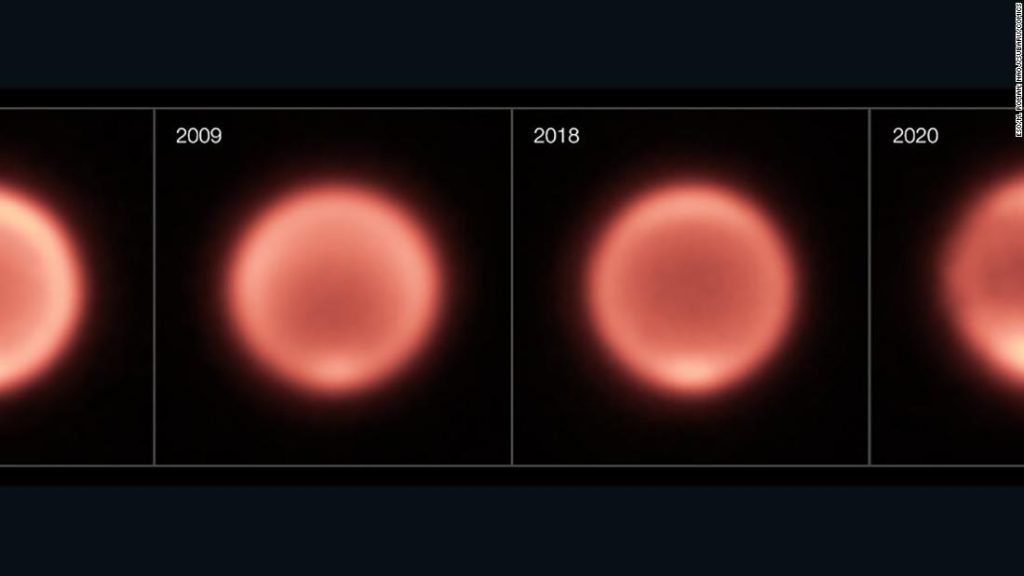Astronomers who have been observing Neptune for the past 17 years using multiple ground-based telescopes have tracked a sudden drop in global temperatures for the icy giant planet, which was then followed by a dramatic warming trend at the planet’s south pole.
Neptune, which orbits the Sun at a distance of 2.8 billion miles (4.5 billion km), goes through seasons like Earth – they last longer. One year on Neptune lasts about 165 Earth years, so one season can last about 40 years. It’s been summer in the southern hemisphere of Neptune since 2005.
Astronomers decided to track the temperatures of the planet’s atmosphere once the southern summer solstice occurred that year.
Nearly 100 thermal images of Neptune taken since then have shown that much of Neptune is gradually cooling, declining by 14°F (8°C) between 2003 and 2018.
“This change was unexpected,” said study lead author Michael Roman, a postdoctoral researcher at the University of Leicester, in a statement. “Since we were observing Neptune during the early southern summer, we expected the temperatures to be warmer, not colder.”
Then, there was a significant warming in the south pole of Neptune between 2018 and 2020, and temperatures rose by 20 degrees Fahrenheit (11 degrees Celsius). This warm polar vortex completely reversed any cooling that had occurred before.
This kind of polar warming has not been seen on Neptune until now.
“Our data covers less than half of Neptune’s season, so no one expected to see big, rapid changes,” study co-author Glenn Orton, chief researcher at NASA’s Jet Propulsion Laboratory, said in a statement.
The images were taken using the European Southern Observatory’s Very Large Telescope and the Gemini Southern Telescope in Chile, along with the Hawaii Subaru Telescope, the Keck Telescope and the Gemini North Telescope, as well as data from the now retired NASA Spitzer Space Telescope. Infrared light emitted from Neptune’s stratosphere, or the atmospheric band above the active weather layer, has helped astronomers detect temperature fluctuations.
Frosty Neptune has a temperature of minus 340 degrees Fahrenheit (minus 220 degrees Celsius), and astronomers still don’t know what causes these temperature changes.
At the moment, they considered that the unexpected changes may be due to a number of factors.
“Temperature changes may be related to seasonal changes in Neptune’s atmospheric chemistry, which can change how effectively the atmosphere cools,” Roman said. “But random variation in weather patterns or even response to the 11-year solar activity cycle may also have an effect.”
More observations will be needed to truly explore these possibilities. The James Webb Space Telescope will observe Uranus and Neptune later this year. The space observatory’s mid-infrared instrument can map the chemistry and temperatures in Neptune’s atmosphere and can pinpoint the cause of this shift.
Neptune is more than 30 times farther from the sun than Earth, and is the only planet in our solar system that cannot be seen with the naked eye from Earth. So far, only NASA’s Voyager 2 spacecraft has flown close to Neptune, which happened in 1989.
“I think Neptune is itself interesting to many of us because we still know so little about it,” Roman said. “All of this points to a more complex picture of Neptune’s atmosphere and how it changes over time.”

“Twitter practitioner. Beer evangelist. Freelance gamer. Introvert. Bacon aficionado. Webaholic.”











More Stories
A long solar flare just erupted from the sun. watching video.
Mastodon’s fang reveals migration patterns in North America
Gaia probe reveals stellar DNA and unexpected ‘stellar earthquakes’ | space